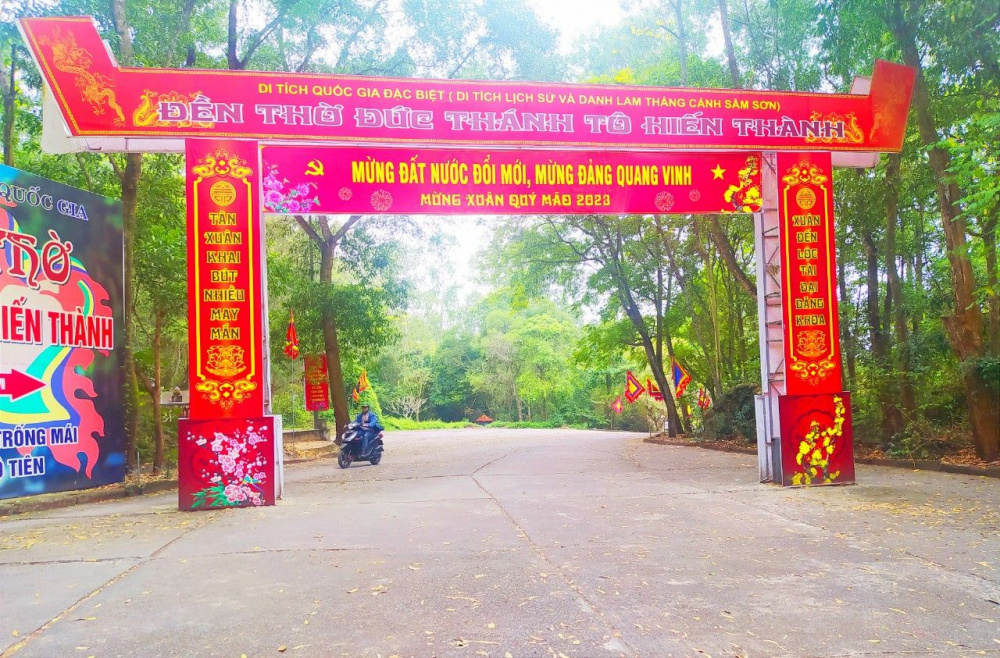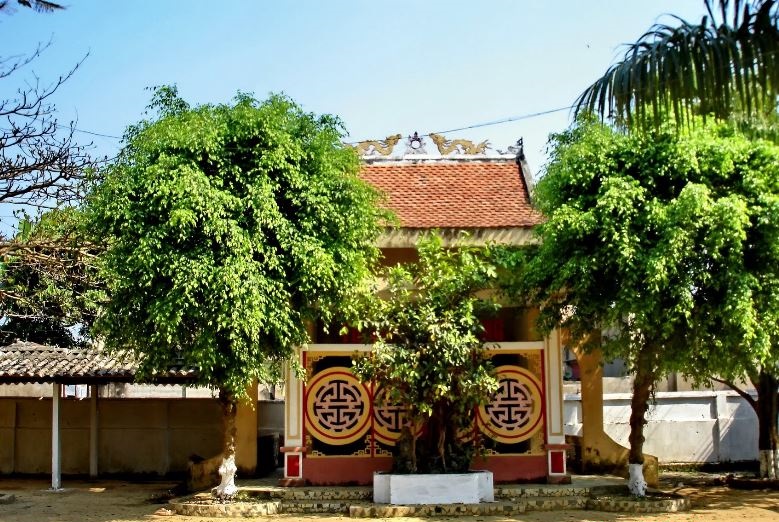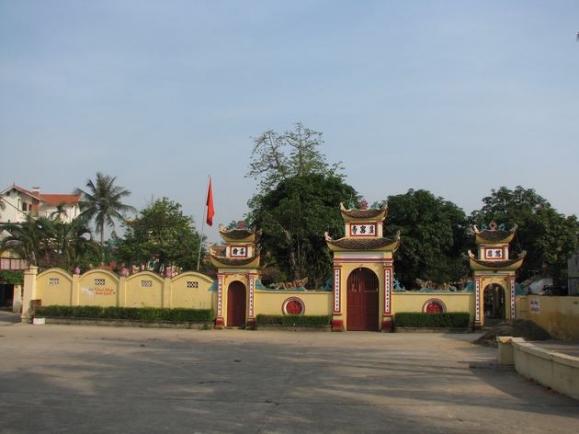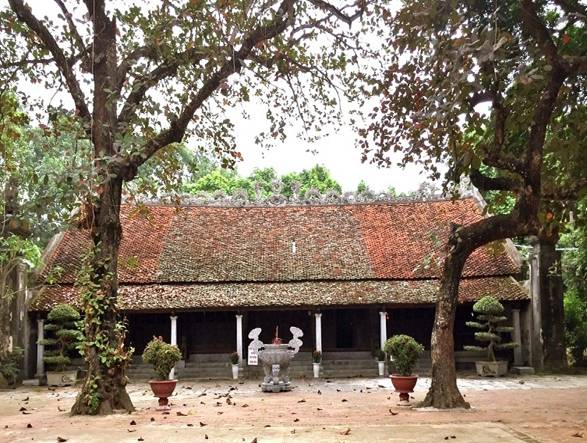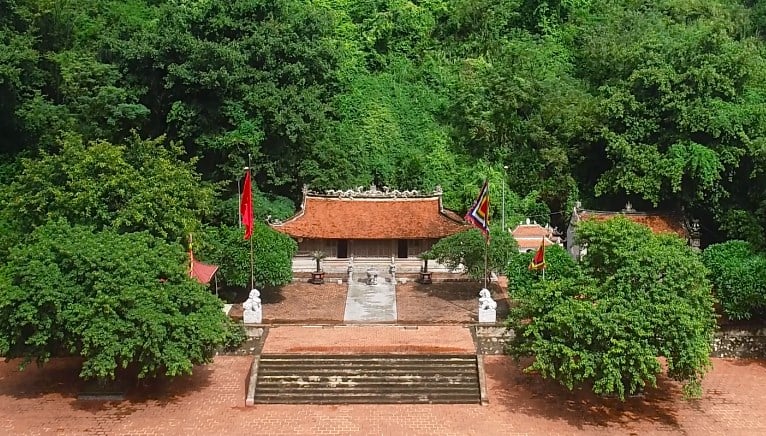Relic point Vietnam
Việt NamTo Hien Thanh Temple
Located on Truong Le mountain, To Hien Thanh temple is a famous ancient temple of Sam Son town in particular and Thanh Hoa province in general. The temple is also called the Second Temple or Trung Temple, is a temple in the system of three temples of Nui village or Sam Thon (Doc Cuoc Temple is the Upper Temple, the First Temple; Hoang Minh Tu Temple is the Third Temple or the First Temple). Ha). Legend has it that the temple has a history of over 800 years, and is the place to worship To Hien Thanh - the main mandarin of the Ly dynasty under the two dynasties of King Ly Anh Tong and Ly Cao Tong. He was a civil and martial officer, famous for his fairness and integrity, and was awarded the title of king by the king even though he was not a member of the Ly dynasty. Through historical ups and downs, the temple has undergone many restorations and new constructions. Currently, the temple has a Dinh-shaped structure, including 3 palaces: Bai Duong, Middle Duong and Hau Palace. The worshiping hall has three compartments to worship the community of mandarins, where ceremonies are held on festivals and his death anniversary... In the middle of the hall is a space where the altar and statue of Mr. To Hien Thanh are placed. The harem examined the saints and ordained them. The temple grounds are spacious and shaded by many trees. The ancient, mossy look of the temple. Source Thanh Hoa province electronic information portal.
Thanh Hoa 3148 view
Co Tien Temple
Co Tien Temple is located on top of Elephant's Head island at the end of Truong Le mountain range to the southwest. Elephant head stone is the fifth stone in the folk classification system. Its name is "Tuong Dau Son" which also means Elephant's Head Mountain, because the Truong Le mountain range running to this place suddenly protrudes a rock shaped like an elephant's head crouching to drink water. Co Tien Temple was built in the Ly Dynasty in an ancient architectural style, consisting of 3 layers: Front Street, Middle Duong and Hau Palace. Dinh-shaped architectural style (or mallet-shaped architecture). Through many degrees of rain, sun, wind and storms and the devastation of war, the temple was seriously damaged. The temple has been restored many times. In the 90s of the twentieth century, the Sam Son City Monuments Management Board repaired a number of items. The most recent renovation in 2010, Sam Son City restored the entire temple but still retained its ancient features. Funding for the construction of the Temple came from donations from people and tourists from all over. The temple was ranked as a National Monument in 1962. Source: Thanh Hoa Provincial Information Portal.
Thanh Hoa 3288 view
Doc Cuoc Temple
Doc Cuoc Temple is a temple dedicated to the god of the same name, a deity in Vietnamese folk beliefs. Doc Cuoc Temple is located on the top of a mountain named Co Giai island in the Truong Le mountain range in Sam Son city, Thanh Hoa province, right next to Sam Son beach. The temple was built during the Tran Dynasty and was restored many times during the Le Dynasty. The path to the temple is 45 stone steps. The wooden statue of Doc Cuoc god has only one arm and one leg. Behind the temple is Mon Lau built in 1863 with wood. In 1962, the temple was ranked as a national monument by the Ministry of Culture and Information of Vietnam. Source Thanh Hoa province electronic information portal.
Thanh Hoa 3731 view
Ba Dinh war zone
The Ba Dinh Uprising (1886 - 1887) was one of the largest and most typical struggles in the Can Vuong movement against the French colonial invasion at the end of the 19th century. Ba Dinh Historical Relic has been recognized as a National Historical Site since 1992. In March 1886, leaders of the Can Vuong movement in Thanh Hoa held a meeting in Dong Bien (Bong Trung now belongs to Vinh Tam commune, Vinh Loc district, Thanh Hoa) to discuss plans to fight against the French. The conference decided to assign Pham Banh, Dinh Cong Trang, and Hoang Bat Dat to be in charge of building the Ba Dinh base in the northern plain of Nga Son district. Ba Dinh base is the place to protect the gateway to the Central region and is a launching pad to attack the enemy in the delta. Ba Dinh is located in the northwest of Nga Son district, including three villages: Thuong Tho, My Khe, Mau Thinh located next to each other. Each village has a communal house and a common village. Ba Dinh is located between sunken fields and two rivers, Hoat River and Chinh Dai River, isolated from neighboring residential areas, especially during the rainy season. Stationed in Ba Dinh, the Can Vuong insurgents could control the river and easily move up to Bim Son and Dong Giao to control Highway 1. Ba Dinh's terrain was very favorable for building a strong defensive fortress. Certainly, Pham Banh, Dinh Cong Trang, and Hoang Bat Dat were assigned to build and command the Ba Dinh base. In just 1 month, the Ba Dinh base was completed, surrounding the three villages is a system of earthen valleys, in some places the base is 9-10 meters wide, the wall is lined with bamboo poles, inside is a layer of mud and sand. Straw makes a very effective target. It is impossible to see inside from the outside, inside there is a moat 4m wide, 3m deep, with sharp bamboo stakes. Across the sunken field is a dense bamboo wall that covers all three sides: North, West, and Southwest. At first, the Ba Dinh insurgent army only had about 300 people, but was later supplemented. The weapons of the insurgents were muskets, rifles, bows, crossbows, and a few cannons organized into 10 squads, each squad of about 30 people led by a soldier. The supreme leader of the Ba Dinh base is Military Affairs Officer Pham Banh, while the direct commander Dinh Cong Trang is considered the soul of the Ba Dinh uprising. The Ba Dinh insurgent force sometimes numbered up to twenty thousand people, recruited from three villages and Thanh Hoa regions, including Kinh, Thai, and Muong people. The insurgent army has 10 groups, each group has a commander. Regarding weapons, the insurgents armed themselves with muskets, spears, and bows and crossbows. In 1886, the insurgents continuously attacked palaces, cities, and district capitals, blocking convoys and individual troops, causing many losses to the French army. On March 12, 1886, taking advantage of the market day, he attacked the Thanh Hoa Legation. And then, the insurgents attacked many citadels, blocked convoys, and caused a lot of damage to the French army. From December 18, 1886 to January 20, 1887, Colonel Brissand led 76 officers and 3,500 troops to siege and attack Ba Dinh base. The French army fired up to 16,000 cannonballs within a day, turning the Ba Dinh base into a sea of fire. The Ba Dinh insurgent army fought for 32 days and nights against an enemy 12 times larger, equipped with modern and advanced weapons. In this extremely fierce battle, the insurgents showed bravery and cunning, but because of the enemy's strong firepower, the Ba Dinh insurgents suffered many casualties. To avoid being completely destroyed, the Ba Dinh insurgents opened a bloody road through the dense siege of the French army and withdrew to the Ma Cao base. On the morning of January 21, 1887, the French army captured Ba Dinh. After that, the French army completely destroyed all three villages of the Ba Dinh base, continued to send troops to pursue the insurgents in Ma Cao, and then destroyed this post on February 2, 1887. After that, a large number of insurgents withdrew to Thung Voi, Thung Khoai, then to western Thanh Hoa to merge with Cam Ba Thuoc's insurgent army. In the end, leader Nguyen Khe died in battle. Pham Banh, Ha Van Mao, Le Toai committed suicide... Hoang Bat Dat was later captured and beheaded by the French because of his indomitable spirit and not surrendering to the enemy. Dinh Cong Trang fled to Nghe An. The French army offered a very high reward on his head. In October 1887, because of greed for reward money, the chief of Chinh An village secretly informed the French army to arrest and kill Dinh Cong Trang. The Ba Dinh uprising and Ba Dinh leaders are highly appreciated by history. President Ho Chi Minh later chose the name Ba Dinh to name Ba Dinh Square, where the Declaration of Independence was read, giving birth to the Democratic Republic of Vietnam. Source: Thanh Hoa Electronic Newspaper
Thanh Hoa 3896 view
Chu Van Luong Temple
Chu Van Luong Temple (also known as Nam Ngan village communal house), formerly located in Nam Ngan commune, Tho Hac canton, Dong Son district, Thieu Thien district, now Nam Ngan ward, Thanh Hoa city. The temple worships Doc Liet Hau, Chu Van Luong, who was instrumental in teaching literacy, preparing medicine, clearing land, establishing Nam Son hamlet, Nam Ngan camp, and organizing the people here to fight the enemy and defend the village. , had many merits in the war against the Mongol Yuan army in the early 13th century. After his death, King Tran bestowed the title of "Superior Phuc Than" on him and authorized the people of Nam Ngan camp to preserve and worship. The villagers worshiped him as the village's Thanh Hoang. The temple was built during the Tran Dynasty outside the Ma River dyke. In the 4th year of Bao Thai's reign, Le Du Tong (1723) was moved along with Mat Da Pagoda to the current land. Over the dynasties, the temple was repaired by the royal court, bestowing more titles and beautiful titles on the gods. Chu Van Luong Temple was ranked a National Historical and Cultural relic by the Ministry of Culture and Sports on November 6, 1989. Currently, the temple still preserves many unique carvings in the artistic style of the Nguyen Dynasty (19th century), along with many worship objects of the Le and Nguyen dynasties with cultural and historical value such as: Sac altar, throne, tablet, tablet, stone stele... The festival is held on his birthday, the 18th day of the second lunar month and his death anniversary, the 12th day of the 9th lunar month, with many unique folk games and performances. Currently, the temple has the following geographical location: The north borders Duc Tien alley, the south borders Mat Da pagoda and people's houses, the east and west border people's houses. The total land area according to the minutes zoning the protected areas of Chu Van Luong temple relics is 0.140 hectares. The estimated land area for planning research is 0.142 hectares. Source: Thanh Hoa city website
Thanh Hoa 4095 view
Mat Da Pagoda
Mat Da Pagoda belongs to the Nam Ngan Historical Relics cluster, Nam Ngan ward (Thanh Hoa city), which was recognized as a national historical-cultural relic in 1989. According to the preserved epitaph, Mat Da Pagoda was initially outside the Ma River dyke, in Hoa Binh hamlet, Nam Ngan commune, built in the Later Le dynasty - the fourth year of Bao Thai's reign, the year of Quy Mao 1723. Initially, the pagoda was just a thatched house with mud walls, used to worship Buddha. The Buddha statue is embellished with terracotta and is very beautiful, respectful, and dignified. Mat Da Pagoda is an ancient pagoda of Thanh Hoa that still retains its integrity with the typical architecture of pagodas in the Northern Delta. The word "Mat Da Tu" means a place with fragrant flowers and sweet fruits of Buddha's land, with many blessings, so since ancient times, the pagoda has attracted many visitors from all over to worship, express spirituality, pray for blessings, Do good deeds to help people. The pagoda's landscape and decorative patterns are very unique. The scale of the pagoda has Dinh-shaped architecture, including 5 front halls and 2 back halls. Inside the main hall, there is a large painting painted in gold and carved with three words "Mat Da Tu". In the middle space there are 4 words "Dharma realm Mong Huan". The outermost room hangs a painting with the four words "The three worlds are supreme". The harem is the Three Jewels palace where the Buddha statue is placed. To the southwest of the pagoda are the Monk's house and the Patriarch's house. The structure of the pagoda has a solid wooden frame, ironwood columns, and a curved roof made of terracotta tiles. The pagoda is quite complete with Dharma statues. In particular, the pagoda has two statues of dharma protectors, promoting good and eliminating evil, over 3 meters high. After being built and embellished many times, the pagoda's sculptural architecture has undergone harmonious changes interwoven with the arts of the Tran, Le, Nguyen dynasties... The pagoda has 4 very beautiful statues of merit from the ten directions. At stele number 2 on the left side of the pagoda, it is written that this pagoda was restored during Bao Dai's reign in the 3rd year of Mau Thin, 1928. Mat Da Pagoda is not only a beautiful and sacred pagoda in the hearts of the people, but also bears the mark of a historical relic, instrumental in the war of sabotage of the American imperialist invasion. Officers, soldiers and people of Ham Rong - Nam Ngan never forget the image of the monks in the temple actively participating in the fighting. Mat Da Pagoda became the command post of the battlefield protecting Ham Rong Bridge, a gathering place for food, ammunition, and first aid and nourishment for wounded soldiers. Located only nearly 2km from Ham Rong Bridge as the crow flies, Mat Da Pagoda has become an important place to treat wounded soldiers in the battlefield protecting Ham Rong Bridge. Mat Da Pagoda will live forever with the heroic history of the nation and in the minds of monks, nuns, fellow Buddhists and people of the country as well as of Nam Ngan - Ham Rong, Thanh Hoa. Source: Thanh Hoa Newspaper
Thanh Hoa 4019 view
Thai temple of the Later Le Dynasty
Located on Kieu Dai street, Dong Ve ward, Thanh Hoa city, the Later Le Dynasty Thai Temple is quiet and peaceful next to the shadows of ancient trees over 200 years old. A place where posterity pays homage to the Later Le Dynasty - the longest feudal dynasty in Vietnamese history. The Thai Temple of the Later Le Dynasty, also known as Le Temple, Bo Ve Temple, was built in the 4th year of Gia Long (1805) as a common place of worship for kings, queens, Queen Mother, Trieu To, and Hien. Patriarch, Tuyen To and other princes and mandarins of the later Le dynasty. The highlight of the Thai Temple is shown in its unique artistic architecture, in the architectural style of the Late Le and Nguyen dynasties, with works: Nghinh gate, palace yard, front palace, back palace. Through Nghinh Mon is a letter scroll (built in 1805), one of the ancient artifacts still preserved. The Thai temple consists of 2 buildings: the front hall and the back palace, arranged side by side in a overlapping style (Nhi style) with 7 compartments, the roof is covered with funny-nosed tiles, the top is elaborately decorated with the symbol "two dragons". moon adoration". In front of the front hall, there are two 6m high pillars and statues made from jackfruit wood, delicately carved, imbued with ancient sculpture art. In the middle of the Tien Dien hangs a large horizontal panel with 6 words engraved: "Southern country of the mountains and rivers try themselves" (meaning our country of the South comes from here), next to it is a small line of letters recording the year the temple was built, 1805. Despite the changes of time and many restorations, the Le Dynasty Thai Temple still retains many valuable artifacts. This place currently houses the altar tablets of 27 kings, the Queen Mother and the princes of the Later Le Dynasty. Among them are four ancient saints of kings Le Thai To, Le Than Tong, Le Huyen Tong and Le Gia Tong. With its cultural and historical values, in 1995, the Thai Temple of the Later Le Dynasty was recognized as a National Historical Cultural and Architectural Art Monument. More than 200 years have passed, the Imperial Temple of the Later Le Dynasty stands majestically, ancient and sacred, a place for posterity to find, contemplate, and express gratitude to their ancestors, a place to preserve values. History and culture help posterity partly understand a historical development path so that they can be more proud and love the land where they were born and raised. Source: Thanh Hoa Radio and Television
Thanh Hoa 4410 view
Mai An Tiem Temple
Mai An Tien Temple is located in Nga Phu commune, Nga Son district, 5km northeast of Nga Son district capital. The small, simple temple nestled on the side of the mountain but contains a beautiful legend that has been passed down for generations. The architecture of the temple is quite simple, the temple is structured in the shape of the letter Dinh including 5 Tien Bai compartments and 4 Hau palace compartments modeled after the architecture of Vietnamese communal houses and temples, with a traditional four-pillar gate. The interior of the temple is arranged solemnly and neatly. Visiting the temple of the legendary figure - Mai An Tiem, the creator of the red watermelon, everyone feels moved by the symbol of the spirit of overcoming difficulties, diligence, and creativity in work. Legend has it: During the reign of King Hung Vuong the 6th, Mai Yen - name An Tiem, former Minister of the Ministry of Spring and Autumn, due to his many merits, was loved by the king and gave him his daughter in marriage. Beloved by the king, he was hated and harmed by the feudal lords and generals; once because he displeased the king, he and his family were exiled to a deserted island to live. Thanks to the crows bringing the fruit to eat, Mai Yen tried to chase away the crows and tried it. It was delicious and unusually sweet, so she planted the seeds. The first season gave many fruits and that fruit fed Mai Yen's family. Hey people call it watermelon. One incident followed another, more and more watermelons, Mai Yen's family couldn't use them all, so they thought of a way to carve words into the fruit's skin and throw them into the sea. The tide pushed the melons to shore. The military officer saw this and immediately reported. to the king, everyone ate together and happily praised the deliciousness. The king knew that Mai Yen and his wife and children were not dead but still remembered the king and sought to offer delicious fruits; The king immediately ordered Mai Yen to be brought back to the mainland to restore his title. With profound folk significance, in the first year of Duy Tan, the king ordained Ngoai village, Nga Son district to worship Mai Yen with the title An Tiem Duc Bao Trung Hung Linh Phu chi god. In the 9th year of Khai Dinh, the king conferred the title of Doan Tuc deity and ordered Ngoai village to continue worshiping him. Special standards allow for worship and use during national holidays. In 1989, Mai An Tiem temple in Nga Phu commune, Nga Son district was ranked as a provincial cultural and historical relic. Every year, on the 12th to 15th day of the third lunar month, at Mai An Tiem temple, the local government and people often organize a festival to commemorate and pay tribute to Mai An Tiem, the person who had the merit of discovering and expanding the land. territory, the ancestor of farming for the people in the region. The image of Mai An Tiem and the legend of the watermelon are the strong vitality of our people in the early days of building the country. Source: Thanh Hoa Tourism
Thanh Hoa 4534 view
Ham Rong Bridge
The historic Ham Rong Bridge is located on the North - South route of the "masterpiece" land of Thanh Hoa, charming mountains and water crossing the Ma River, with unique architecture, associated with the development history of the land. The heroic land of Thanh Hoa, the strong will of Thanh Hoa people. Ham Rong Bridge is the first bridge to cross the Ma River in Thanh Hoa, nearly 5km north of Thanh Hoa City center... This is also the only railway bridge to cross the Ma River by France. Built in 1904 in the style of a steel arch bridge without pillars, the most modern in Indochina at that time. In 1946, the bridge was destroyed according to the scorched earth resistance policy of the Viet Minh to stop the advance of the invaders. In 1963, the bridge was restored by Soviet and Chinese experts helping to design and construct it, becoming the current pier bridge, with a width of 17 meters, consisting of 2 steel girder spans, with a railway in the middle. , on both sides are car roads and pedestrian roads. During the escalating war against the North of our country, the US Air Force focused on raiding Ham Rong Bridge to cut off important traffic arteries and prevent support from the Northern rear to the major battlefield in the South. The destruction of Ham Rong was chosen by the White House and the Pentagon as the most important goal in the first war of sabotage in the North. With a plot to cut off North-South support, isolate Ham Rong and focus on completely defeating Ham Rong, at 8:45 a.m. on April 3, 1965, the first 16 American planes bombed the area. Thanh Hoa with a series of raiding locations such as Do Len bridge (Ha Trung), Cun bridge (Nong Cong), Van Trai station (Tinh Gia)... In just two days, April 3 and 4, 1965, the US military used 174 groups and 454 aircraft; threw 627 explosive bombs, 58 slow-explosive bombs (including types from 500 to 1,000kg), and hundreds of missiles and rockets into key areas of Thanh Hoa. In the Ham Rong - Nam Ngan - Yen Vuc area alone, the enemy dived 85 times, bombed and bombarded 80 times, threw 350 bombs, and fired 149 rocket shells. To protect Ham Rong Bridge, on our side, in a working session with the Standing Committee of the Thanh Hoa Provincial Party Committee in December 1967, comrade Le Duan affirmed: "If Military Region IV is important, then Thanh Hoa is important." especially because Thanh Hoa is the direct rear of the Binh - Tri - Thien and Laos fronts. Thanh Hoa Provincial Party Committee commented: "The key point of attacking the military zone at this time is Thanh Hoa, the key point of Thanh Hoa is Ham Rong, protecting Ham Rong bridge is to contribute to protecting smooth traffic." Due to the particularly important location of Ham Rong Bridge, at the North and South ends of the bridge there are two mountains, Ngoc Mountain and Dragon Mountain, which can block most falling bombs. After 2 days of stubborn fighting, Thanh Hoa shot down 47 American enemy planes, captured many enemy pilots, and protected the safety of Ham Rong Bridge. This has proven that the Party's people's war policy, the Party's military art and our people's revolutionary heroism have gone down in history as a legend that has stirred up American public opinion and made our friends love us. justice and peace around the world admired. Years passed. Ham Rong Bridge with the two words "Quyet Thang" majestically carved into the mountainside is a shining symbol of patriotism and revolutionary heroism of the Vietnamese people. For every child of Thanh Hoa, Ham Rong - Ma River is also the embodiment of the homeland, both close and familiar, very sacred and proud. Source: Thanh Hoa School of Politics
Thanh Hoa 6894 view
Le Hoan Temple
Le Hoan Temple in Trung Lap village, Xuan Lap commune, Tho Xuan district (Thanh Hoa) is a special national historical relic and is considered the oldest temple in Thanh Hoa. Le Hoan Temple is in a hundred-year-old village, where the founder of the glorious Early Le Dynasty in the nation's history was born - Emperor Le Dai Hanh. Currently, there is still a temple worshiping the King at the end of the village, known as one of the most ancient temples in Thanh Hoa and recognized as a special national historical site. According to history books, Le Hoan was born on July 15, Tan Suu year (941) at Ke Xop site, Di Phong Chau Ai district (now Trung Lap village, Xuan Lap commune, Tho Xuan district, Thanh Hoa province) in a family. poor farmers. Father is Le Mich, mother is Dang Thi. When he was 6 years old, Le Hoan lost both parents and became the adopted son of Mr. Le Dot in Ke Mia village (now Phong My village, Truong Xuan commune, Tho Xuan district, Thanh Hoa). When he grew up, Le Hoan joined the army to help Dinh Tien Hoang quell the rebellion of 12 military lands, achieved many merits and was awarded the title of General of the Ten Commandments. He wholeheartedly supported and contributed to King Dinh to bring peace to hundreds of families and a peaceful country. In the winter of October of the year Ky Mao (979), King Dinh Tien Hoang and his eldest son Nam Viet Vuong Dinh Lien were murdered by Do Thich. Le Hoan was appointed regent, helping the young lord of the Dinh dynasty keep the border and society in peace, suppressing internal rebellion, and was given the royal robe by Queen Mother Duong Van Nga. In the year of the Dragon 980, Le Hoan ascended the throne and took the reign name Thien Phuc. The king defeated the Song army, kept the land in peace, conquered Champa and gradually asserted the sovereignty of the country and nation, minting Thien Phu coins, focusing on the development of agriculture, handicrafts, transportation and trade. After that, Le Hoan died on March 8, At Ty year (1005) in the ancient capital of Hoa Lu - Ninh Binh province. Le Hoan's body was buried in Son Lang, Truong Yen district, on the throne for 24 years, at the age of 65. The temple's title is Dai Hanh Emperor. Source: Tho Xuan District electronic information portal
Thanh Hoa 4863 view
